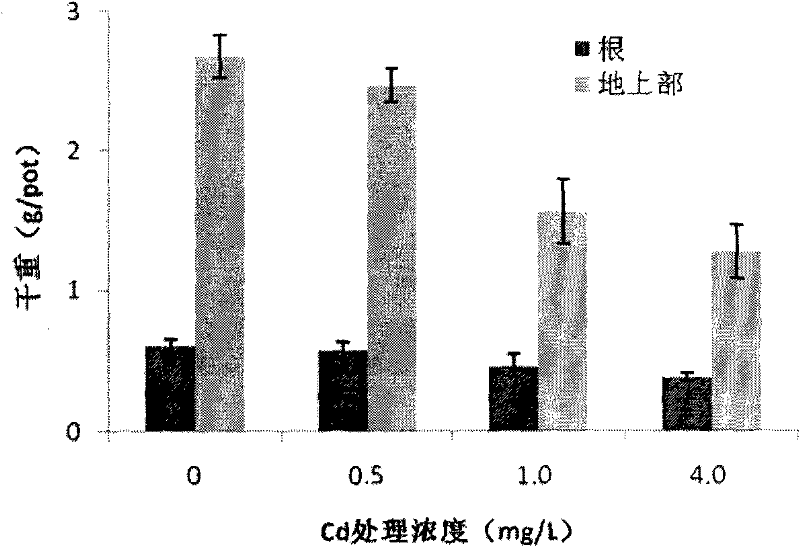Method for remediating cadmium contaminated soil by using ornamental plant smooth joyweed
A technology for cadmium-contaminated soil and ornamental plants, applied in the restoration of polluted soil and other directions, can solve the problems of difficulty in large-scale popularization and application, lack of independent intellectual property rights, difficult cultivation and specialization, etc. The effect of damaging the polluted site and improving the ornamental value
- Summary
- Abstract
- Description
- Claims
- Application Information
AI Technical Summary
Problems solved by technology
Method used
Image
Examples
Embodiment 1
[0016] Example 1: Absorption of red amaranth to cadmium under hydroponic conditions
[0017] Experimental method: This experiment was carried out in the artificial climate room of the Environmental Protection Research and Monitoring Institute of the Ministry of Agriculture. Plant seeds are soaked in 1% sodium hypochlorite solution for 10 minutes and fully rinsed with sterile water, scalded with warm water at 35°C, soaked for 8 hours after natural cooling, and spread in a mixture of perlite and vermiculite (1:1) sterilized by high temperature and high pressure. ) substrate, sprinkle a layer of fine vermiculite to cover the seeds, and germinate in an artificial climate chamber (the temperature is 25°C, and the light time is 16h). Add deionized water every day for cultivation, and after the 3-leaf stage, use 1 / 4 Hoagland culture medium (Hoagland and Arnon, 1938) to irrigate instead. One week after the culture solution was poured, healthy seedlings of the same size were selected ...
Embodiment 2
[0023] Example 2: The enrichment characteristics of red amaranth to Cd under soil culture conditions
[0024] Experimental method: This experiment was carried out in the glass greenhouse of the Environmental Protection Research and Monitoring Institute of the Ministry of Agriculture. Pot experiments were carried out with cadmium-contaminated soil, the soil pH was 6.6, and the total amount of cadmium was 4.5mg / kg. The soil is air-dried, sieved, and thoroughly mixed. Put in pots, 5 kg of soil in each pot, and apply urea, ammonium dihydrogen phosphate and potassium sulfate to make N, P, and K reach 150, 100, and 150 mg / kg, respectively. The seeds were sterilized with 1% sodium hypochlorite solution for 10 minutes, washed, scalded with warm water at 35°C, cooled naturally and then soaked for 8 hours. Sow about 8 seeds in each pot, thin out the seedlings after emergence, and keep 2 plants in each pot, regularly water and manage them, and harvest after the plants grow for 2 months...
PUM
 Login to View More
Login to View More Abstract
Description
Claims
Application Information
 Login to View More
Login to View More - R&D
- Intellectual Property
- Life Sciences
- Materials
- Tech Scout
- Unparalleled Data Quality
- Higher Quality Content
- 60% Fewer Hallucinations
Browse by: Latest US Patents, China's latest patents, Technical Efficacy Thesaurus, Application Domain, Technology Topic, Popular Technical Reports.
© 2025 PatSnap. All rights reserved.Legal|Privacy policy|Modern Slavery Act Transparency Statement|Sitemap|About US| Contact US: help@patsnap.com



